27 Types of Blackbirds in Florida (With Pictures)
Last Updated on
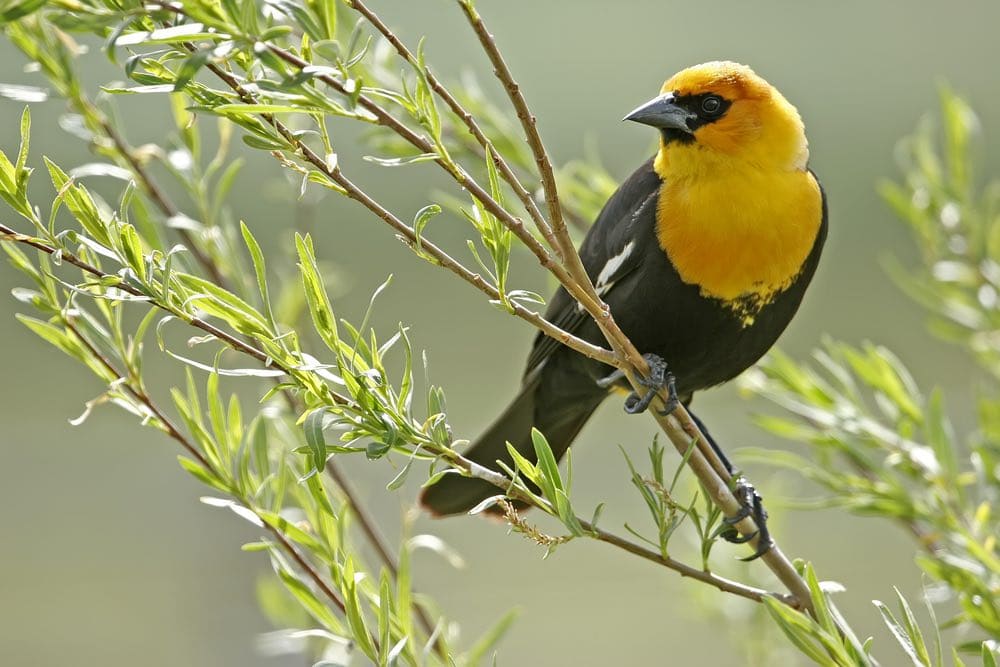
Florida is home to many bird species in various shapes, sizes, and colors. More commonly, you’ll find a variety of blackbirds, each owning a unique appearance, wingspan, diet, and lifespan.
Let’s talk about the 27 most common blackbirds you can find in Florida, some of which may even land in your backyard with the right feed.

The 27 Types of Blackbirds in Florida
1. American Coot

| Scientific Name: | Fulica americana |
| Weight: | 1.7 pounds |
| Wingspan: | 28 inches |
| Lifespan: | 22 years |
| Diet: | Insects, berries, and seeds |
The American Coot is similar to a duck in many ways, but mostly because it’s a waterbird. They can’t fly well, requiring a run-up every time they take off. In addition, they look a lot like ducks while swimming.
In appearance, they have sloping, bright beaks, rounded heads, and a red patch on their foreheads. Considering their small size, these black birds have a surprisingly long lifespan.
2. Anhinga
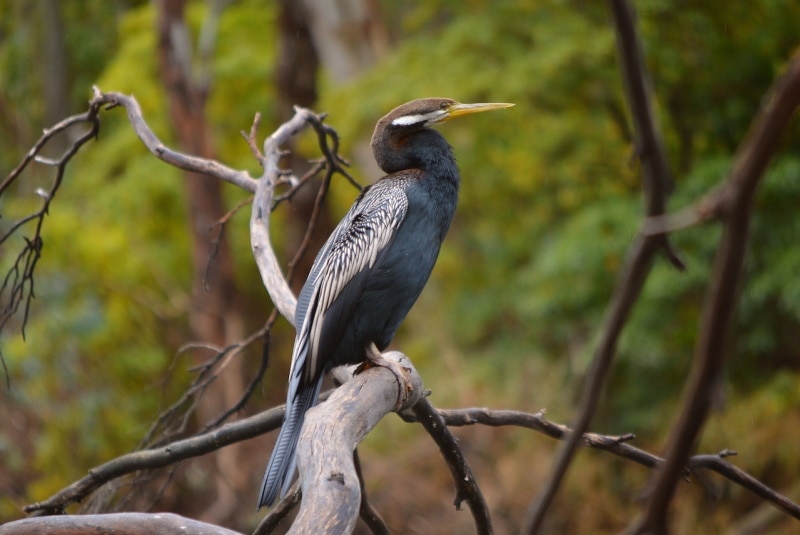
| Scientific Name: | Anhinga anhinga |
| Weight: | 2.7 pounds |
| Wingspan: | 48 inches |
| Lifespan: | 11 years |
| Diet: | Fish and aquatic insects |
Anhingas are also waterbirds except they’re slenderer and larger, with majestic wings fanning out like a turkey’s. Interestingly, you’ll often find them swimming with just their head and neck above water, after which they perch on their legs and outstretch their wings to dry.
Their bills are thin, long, and sharp on an S-shaped neck with silvery black feathers. You can differentiate female anhingas from males by noting the tan feathers on their heads, necks, and breasts.
3. Brewer’s Blackbird
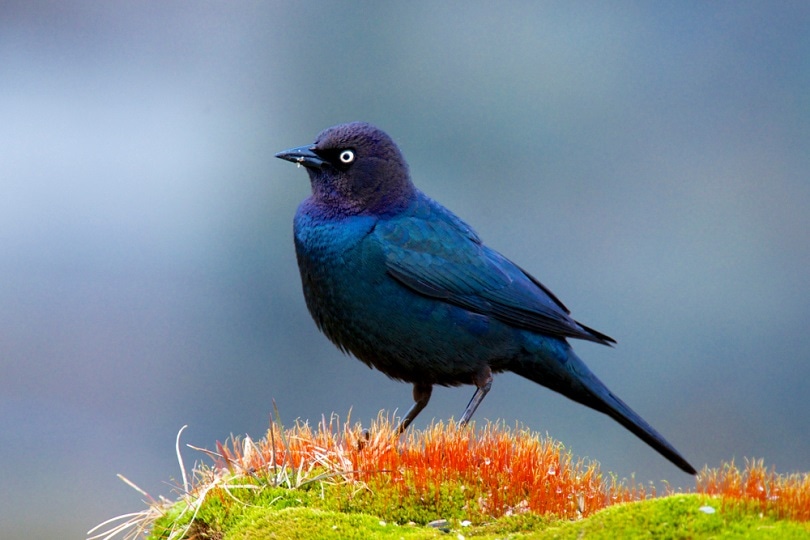
| Scientific Name: | Euphagus cyanocephalus |
| Weight: | 0.18 pounds |
| Wingspan: | 14.6 inches |
| Lifespan: | 12 years |
| Diet: | Insects, berries, and seeds |
The Brewer’s Blackbird feeds on the ground, meadows, grasslands, golf courses, and riversides. Named after the ornithologist Thomas Mayo Brewer, it’s easy to distinguish between male and female species of this bird.
While female Brewer’s Blackbirds have dark brown feathers and dark eyes, males have glossy feathers, yellow eyes, and a bluish shine on their heads.
4. Red-Cockaded Woodpecker

| Scientific Name: | Leuconotopicus Borealis |
| Weight: | 0.12 pounds |
| Wingspan: | 16 inches |
| Lifespan: | 12 years |
| Diet: | Insects |
Red-Cockaded Woodpeckers are an endangered species as most of their habitats are lost, including old-growth pine forests, in which they create cavities for their nests. This small woodpecker species has black heads, white cheeks, and a bold black stripe.
The male’s cockade has a slight red streak and black and white feathers on the back.
5. Rusty Blackbird
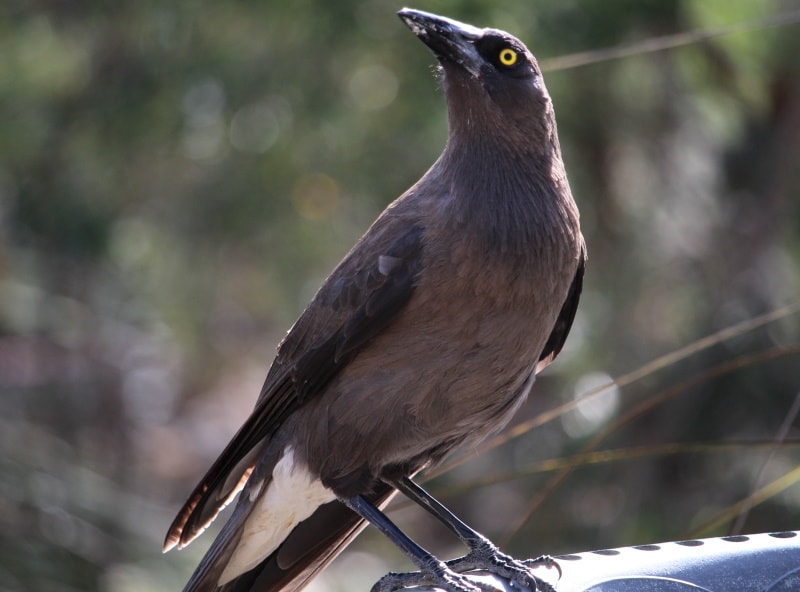
| Scientific Name: | Euphagus carolinus |
| Weight: | 0.17 pounds |
| Wingspan: | 14.6 inches |
| Lifespan: | 8 years |
| Diet: | Insects and plant matter |
Like most blackbirds, the Rusty Blackbird can be easily distinguished regarding its gender. While female Rusty Blackbirds have gray-brown feathers with rusty edges, the males have glossy black feathers, buff eyebrows, and yellow eyes.
Moreover, Rusty Blackbirds feed on insects and plant matter found under leaves and bark on the ground. Considering their small size, these birds have a pretty wide wingspan.
6. Snail Kite

| Scientific Name: | Rostrhamus sociabilis |
| Weight: | 1.25 pounds |
| Wingspan: | 47 inches |
| Lifespan: | 9 years |
| Diet: | Large snails |
Snail Kites are medium-sized raptors with slim and hooked bills, long tails, and broad wings that can span as wide as 47 inches. Male Snail Kites typically have bright yellow beaks with gray tips, black tails with white edges, and dark gray feathers.
Meanwhile, the females have brown feathers, which are white around their faces. With only 1,000 of these birds left, they’re listed as endangered federally and in Florida.
7. White-crowned Pigeon

| Scientific Name: | Patagioenas leucocephala |
| Weight: | 0.66 pounds |
| Wingspan: | 23 inches |
| Lifespan: | 14 years |
| Diet: | Fruits and berries |
The White-Crowned Pigeon is one of the most unique-looking pigeons you can find, with a white head and iridescent green feathers at the nape of its neck. In addition, they have red beaks, red legs, and bright yellow eyes.
Surprisingly, it weighs just over half a pound but can live up to 14 years, feeding on fruits and berries from trees.
8. American Crow
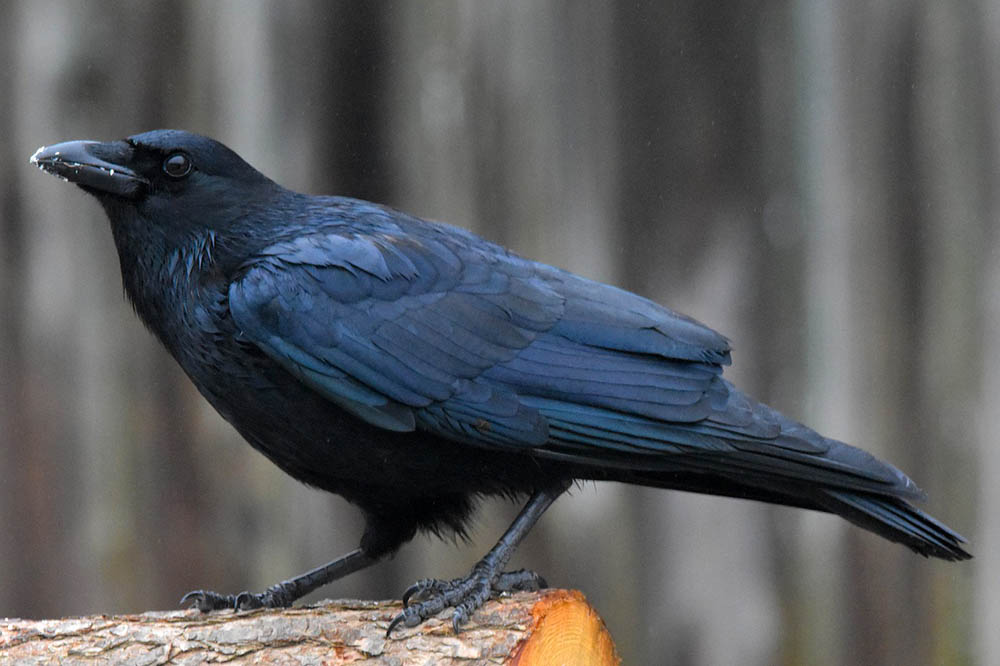
| Scientific Name: | Corvus brachyrhynchos |
| Weight: | 1.3 pounds |
| Wingspan: | 40 inches |
| Lifespan: | 17 years |
| Diet: | Insects, berries, and seeds |
Of course, the American Crow is found all over the country, including in Florida. They’re known for their glossy black feathers and jet-black beaks. While their tail is short and squared off, their wings are fairly broad, stretching as wide as 40 inches.
The best thing about these birds is that they’re intelligent enough to have great problem-solving skills, inhabiting crowded urban areas. That’s where they’ll feed on anything they find, including insects, seeds, and berries.
9. Boat-Tailed Grackle

| Scientific Name: | Quiscalus major |
| Weight: | 0.55 pounds |
| Wingspan: | 20 inches |
| Lifespan: | 12 years |
| Diet: | Grains, crayfish, aquatic insects, and snails |
Boat-Tailed Grackles are attractive songbirds whose every inch is covered with glossy black feathers and sparkle in a bluish hue around their back. These birds are found around the seaside but have also been observed living inland far from the coast.
As omnivores, these birds can consume practically anything they find, including leftover human food, seeds, and even crabs near the coast.
10. Common Grackle

| Scientific Name: | Quiscalus quiscula |
| Weight: | 0.31 pounds |
| Wingspan: | 18.1 inches |
| Lifespan: | 22 years |
| Diet: | Insects, berries, and seeds |
The Common Grackle is a blackbird, and they do indeed look completely black. However, if you take a closer look, their body feathers are a deep bronze color, while their heads have glossy purple feathers. The female birds are similar looking, but they are not as glossy.
They can easily locate food and are common in urban and rural regions. You frequently see these birds sitting on telephone wires because they like to congregate there in flocks.
11. Red-Winged Blackbird
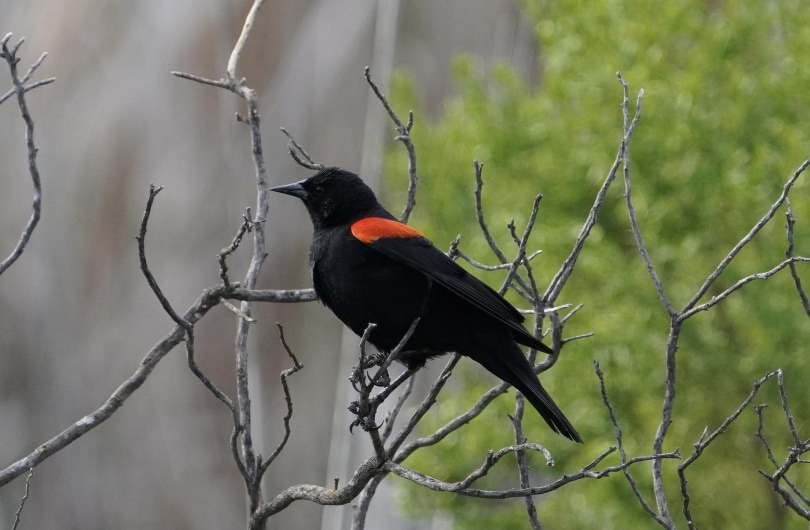
| Scientific Name: | Agelaius phoeniceus |
| Weight: | 0.16 pounds |
| Wingspan: | 15.8 inches |
| Lifespan: | 15 years |
| Diet: | Seeds and suet |
Except for extremely noticeable red and yellow spots on their shoulders, these Red-Winged Blackbirds are entirely black. Their female species lack striking colors and have a darker overall coloration, with one of their distinctive features being their white eyebrows.
Offering a combination of grains like millet, cracked corn, and sunflower seeds can easily attract them. They mainly live in marshes and streams that are both freshwater and saltwater.
12. Smooth-Billed Ani

| Scientific Name: | Crotophaga ani |
| Weight: | 0.15 pounds |
| Wingspan: | 18 inches |
| Lifespan: | 5 years |
| Diet: | Insects, berries, and fruits |
The first thing you’ll notice about a Smooth-Billed Ani is its beak, which resembles a parrot in its shape. This bill has a permanently rigid and an arched top. In the sunlight, the bird’s feathers shine a beautiful shade of bronze.
These birds have all-black plumage and long, tapering tails and prey on lizards, insects, and other small animals. They are typically found in dense scrubland.
13. Swallow-Tailed Kite

| Scientific Name: | Elanoides forficatus |
| Weight: | 1.31 pounds |
| Wingspan: | 53 inches |
| Lifespan: | 6 years |
| Diet: | Lizards, small birds, frogs, and insects |
The eye-catching Swallow-Tailed Kite has a mix of black and white feathers. Their heads and bellies are covered in white feathers, but the feathers surrounding their wings, tails, and backs are entirely black. They have small, hooked black beaks and black eyes.
These kites hunt insects and small animals, including frogs and small snakes.
14. European Starling
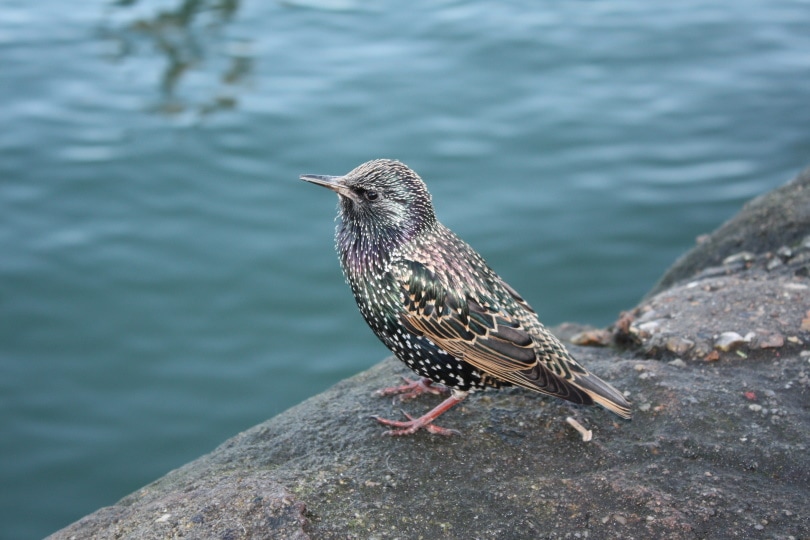
| Scientific Name: | Sturnus vulgaris |
| Weight: | .21 pounds |
| Wingspan: | 15.8 inches |
| Lifespan: | 3 years |
| Diet: | Insects, berries, fruits, and seeds |
European Starlings have black, seemingly glossy feathers and a long, thin beak along with a short tail. The adults have a greenish-purple tint and a much deeper shade of black. Starlings lose their shine in the winter, get white scars all over their bodies, and their beaks darken.
They mostly hunt small insects when available, but in fall and winter, they consume berries, fruits, and seeds.
15. Brown-Headed Cowbird
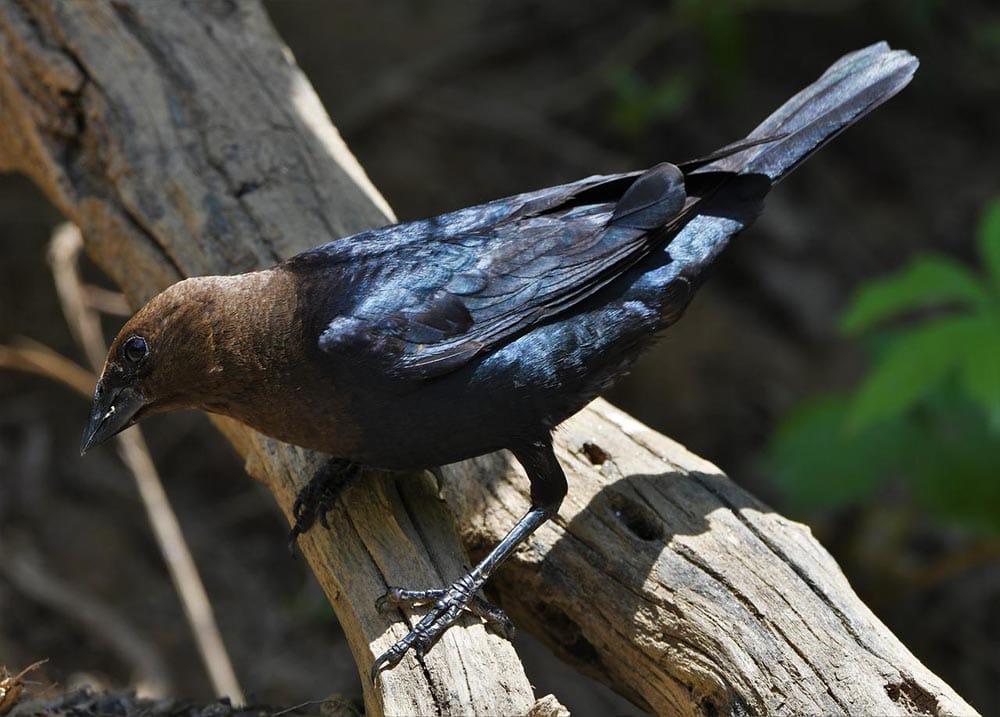
| Scientific Name: | Molothrus ater |
| Weight: | .11 pounds |
| Wingspan: | 14.2 inches |
| Lifespan: | 17 years |
| Diet: | Seeds and insects |
A Brown-Headed Cowbird can be defined as a thick-billed, stocky blackbird with a conical beak. Males have a brown head and an all-black body, while females are a simple shade of brown. Their eyes are deep black and have faint streaks on their bellies.
They mostly consume seeds and insects and can be found in their natural habitat in Florida’s grasslands and woodland margins.
16. Eastern Meadowlark
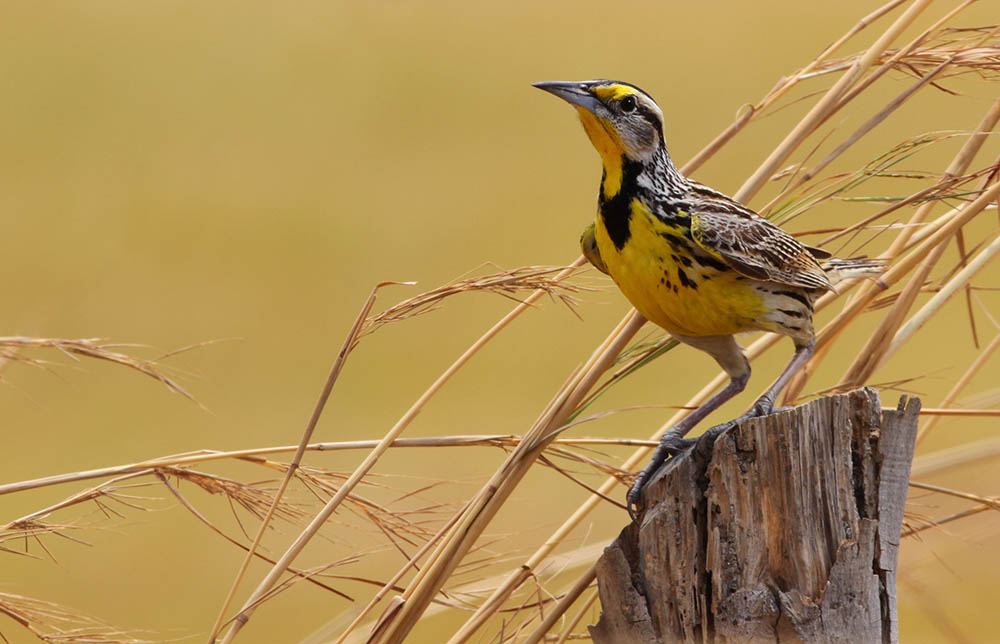
| Scientific Name: | Sturnella magna |
| Weight: | .33 pounds |
| Wingspan: | 15.8 inches |
| Lifespan: | 5 years |
| Diet: | Seeds, waste grain, and insects |
The Eastern Meadowlark is considered a near-threatened species in Florida. Although these medium-sized songbirds are not entirely black, they’re known for their signature black stripe across their chest.
Otherwise, their feathers are bright yellow, tan, and white. Found in grasslands and prairies, their singing indicates that spring has arrived.
17. Baltimore Oriole

| Scientific Name: | Icterus galbula |
| Weight: | 0.08 pounds |
| Wingspan: | 11.8 inches |
| Lifespan: | 14 years |
| Diet: | Insects, berries, and nectar |
The Baltimore Oriole is a striking orange bird, with the males featuring black feathers on the top half, which is why they made their way into this list. You’ll mostly spot them in the winter while feeding on insects and fruits in parks and backyards.
18. Orchard Oriole
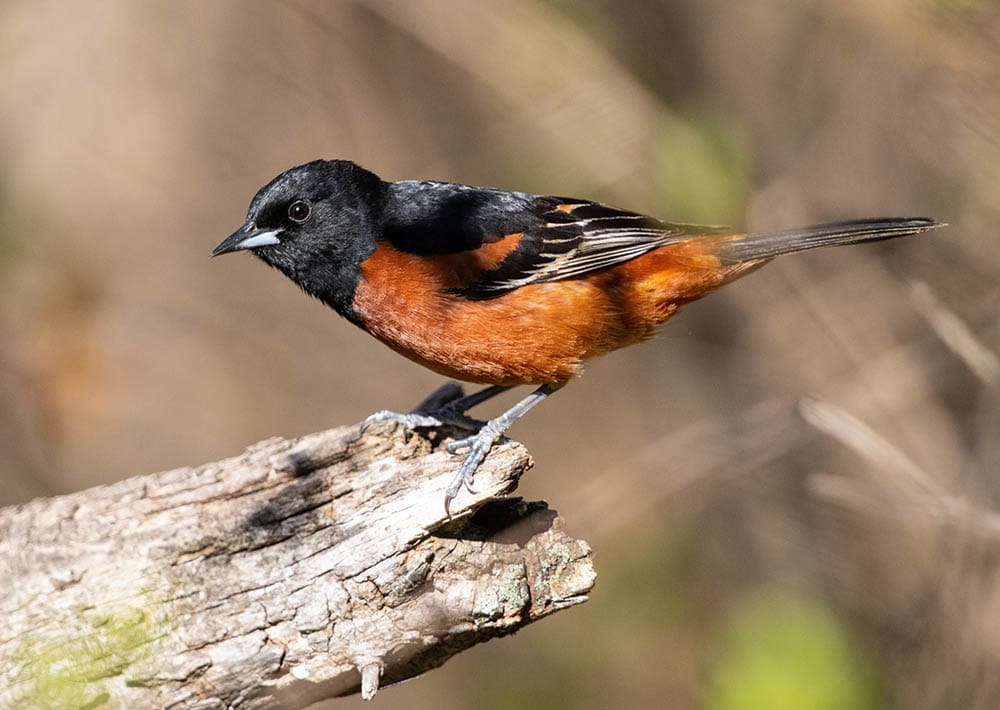
| Scientific Name: | Icterus spurius |
| Weight: | 0.06 pounds |
| Wingspan: | 9.8 inches |
| Lifespan: | 10.9 years |
| Diet: | Insects, berries, and nectar |
The Orchard Oriole is another bird that’s on our list solely due to its male species featuring black feathers on the top half. The bottom half is copper for the male and lime green for the female.
Surprisingly, the male and female Orchard Orioles have little in common regarding their appearances. However, you can find both in South Florida, feeding on ants, caterpillars, beetles, and grasshoppers.
19. Bobolink

| Scientific Name: | Dolichonyx oryzivorus |
| Weight: | 0.12 pounds |
| Wingspan: | 10.6 inches |
| Lifespan: | 6 years |
| Diet: | Insects and seeds |
The Bobolink is a unique-looking bird, with the male being almost entirely black and the female being a dull gray. These birds travel from wintering grounds in South America to breeding grounds in Canada.
You’ll typically find them in marshes and coastal areas, making short “peek” and “check” calls.
20. Spot-breasted Oriole
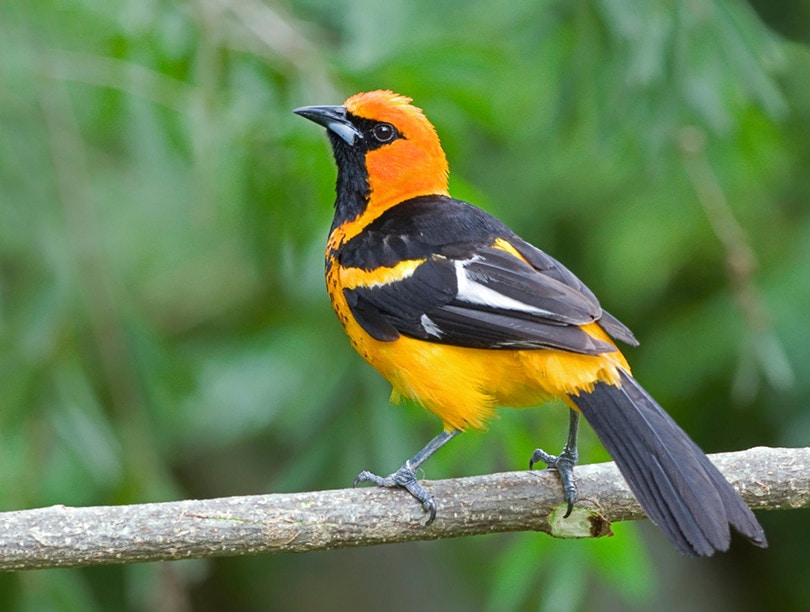
| Scientific Name: | Icterus pectoralis |
| Weight: | 0.11 pounds |
| Wingspan: | 4.5 inches |
| Lifespan: | 12 years |
| Diet: | Berries, nectar, and insects |
Spot-Breasted Orioles are the perfect combination of jet-black and orange with white-edged wings. Typically, you’ll find them along the Gulf Coast, but they’re rare in the US. In Florida, these birds live in dry scrub and open woodlands.
They build their nests with the help of fibers and plants, weaving them into a hanging pouch. If you want to attract a Spot-Breasted Oriole, just place some sugar water and fruit in your backyard.
21. Bronzed Cowbird
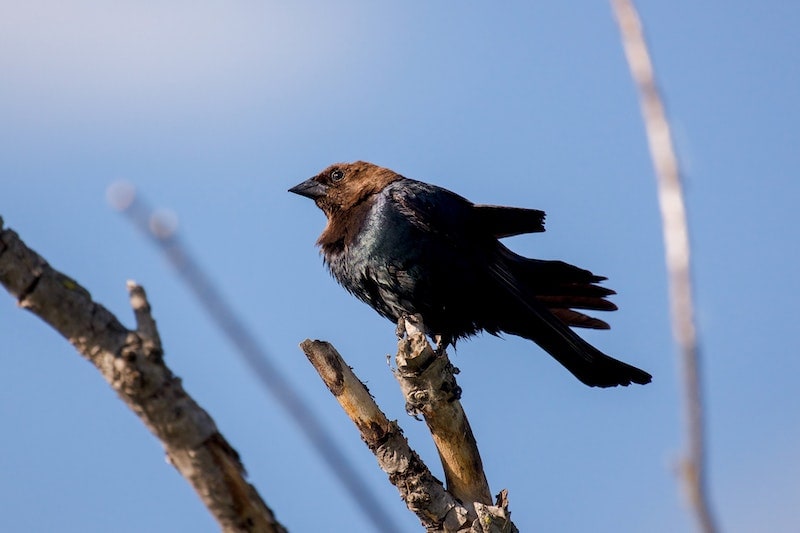
| Scientific Name: | Molothrus aeneus |
| Weight: | 0.16 pounds |
| Wingspan: | 13 inches |
| Lifespan: | 8 years |
| Diet: | Seeds and insects |
You can easily spot Bronzed Cowbirds in Orlando, Tampa, and Miami, as they are bigger than other cowbirds. While female Bronzed Cowbirds have brown feathers and black eyes, males have black feathers, glossy blue wings, and red eyes.
These birds are mostly found in open fields, wooded areas, and pastures, feeding on any seeds and insects they find.
22. Shiny Cowbird
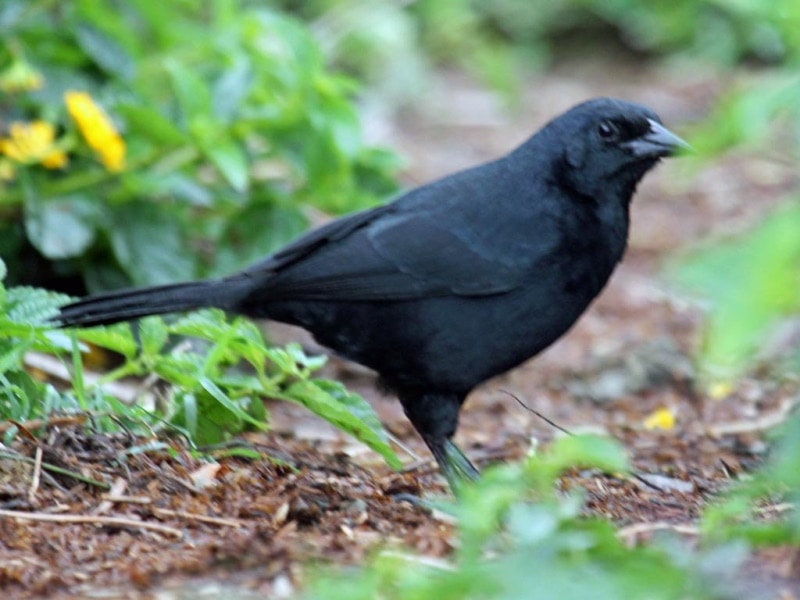
| Scientific Name: | Molothrus bonariensis |
| Weight: | 0.08 pounds |
| Wingspan: | 11.8 inches |
| Lifespan: | Unknown |
| Diet: | Insects, arthropods, and seeds |
The beautifully dark Shiny Cowbirds are mostly found in open and semi-open areas, including farm fields, parks, gardens, and roadside ditches. From a distance, the males look almost black, but up close, they are velvety purple.
Females have brown skin with white necks and brows. They hunt in groups, mostly with different blackbird species, and browse on the ground, looking for seeds, grains, and insects.
23. Bullock’s Oriole

| Scientific Name: | Icterus bullockii |
| Weight: | 0.09 pounds |
| Wingspan: | 12.2 inches |
| Lifespan: | 14 years |
| Diet: | Insects, fruit, and nectar |
Bullock’s Orioles consume fruit, nectar, and, sometimes, insects. The females are washed in grey and orange, while the adults are flame-orange with a clean line through the eye and a white wing patch.
One of the specialties of Bullock’s Orioles is that they sing. The males do it more sweetly and frequently than the female.
24. Scott’s Oriole

| Scientific Name: | Icterus parisorum |
| Weight: | 0.08 pounds |
| Wingspan: | 12.6 inches |
| Lifespan: | 5 years |
| Diet: | Insects, berries, and nectar |
The foothills and valleys are where the Scott’s Oriole spends the summer while spreading their rich, beautiful whistles around and feeding on insects and nectar.
Males are lemon yellow and have a black back, head, and breast while being large and slender with a thin, pointed beak that is slightly curled. Meanwhile, female Scott’s Orioles have beautiful pastel colors and lack a black hood and back.
25. Hooded Oriole
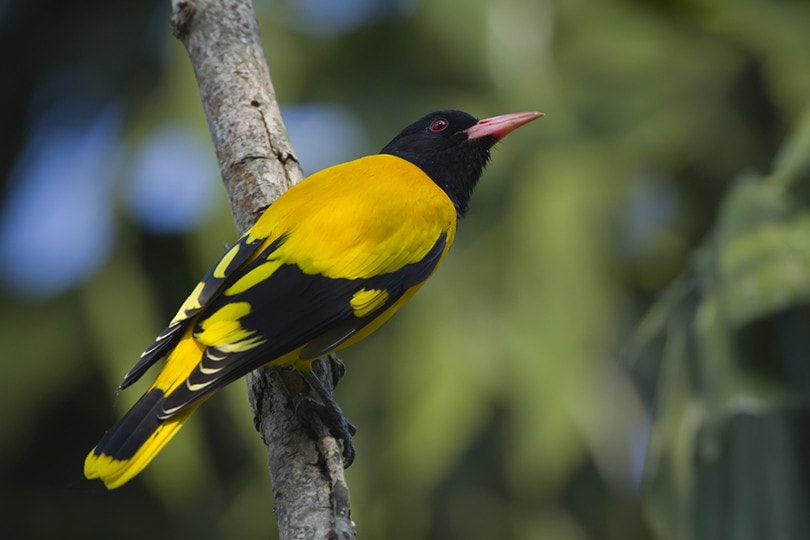
| Scientific Name: | Icterus cucullatus |
| Weight: | 0.05 pounds |
| Wingspan: | 11 inches |
| Lifespan: | 5 years |
| Diet: | Fruit and nectar |
In comparison to other orioles, the Hooded Orioles are longer and more delicately built. Adult males have a black neck and extend up around the eye, ranging in color from bright yellow to blazing orange.
The overall color of females is olive-yellow, with grayer backs and narrow white wing bars and the back’s unspotted gray color. These beautiful songbirds feed on nectars and insects.
26. Western Meadowlark
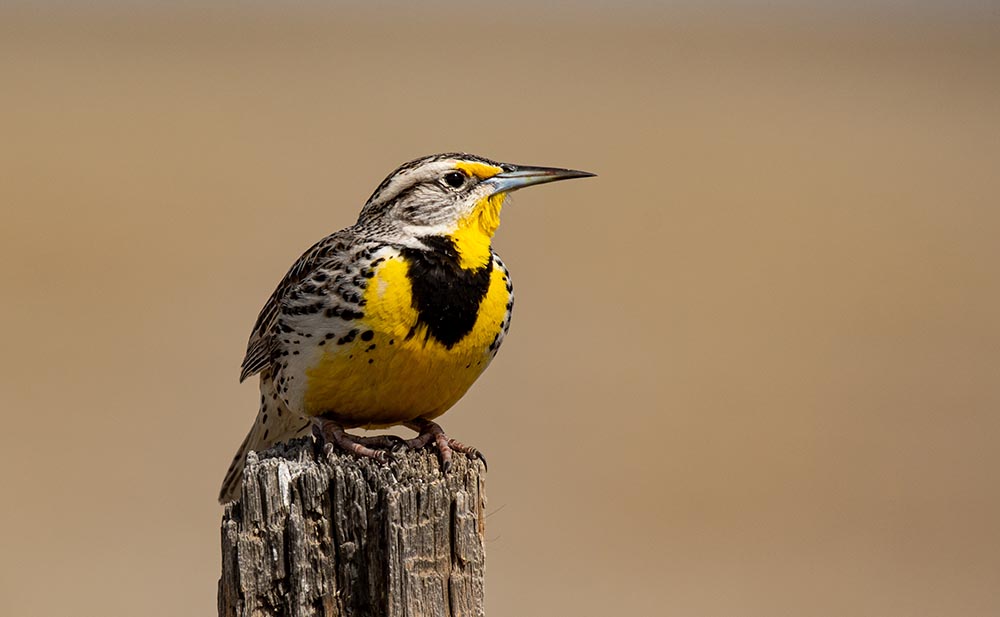
| Scientific Name: | Sturnella neglecta |
| Weight: | 0.25 pounds |
| Wingspan: | 16.1 inches |
| Lifespan: | 6 years |
| Diet: | Insects and seeds |
Though Western Meadowlarks are quite pleasant to look at, they are classified as “accidental species.” They share a similarity with robins in terms of size. With black, brown, and white colors taking over their bodies, these birds look like they fit the summer season well, which is why they move to warmer areas when winter arrives.
27. Yellow-headed Blackbird
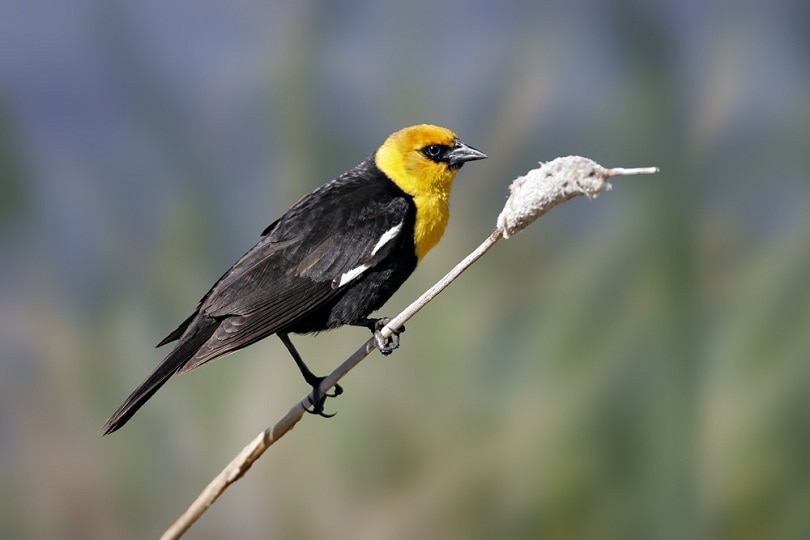
| Scientific Name: | Xanthocephalus xanthocephalus |
| Weight: | 0.21 pounds |
| Wingspan: | 17.3 inches |
| Lifespan: | 11 years |
| Diet: | Insects and seeds |
As the name suggests, these birds have marvelous, black-colored bodies, with yellow color taking over their chest and head area. However, the difference between males and females is that the former has a touch of white in their wings, and the latter have brown bodies instead of black.
They enjoy seeds and insects as meals and prefer warmer areas in the winter.

Conclusion
Blackbirds are found all over the US, but most commonly in Florida’s wooded areas where they migrate to their breeding grounds.
Most of Florida’s blackbird population consists of songbirds, but you’ll also find raptors and waterbirds. With the right feed, you can attract most of these birds to your backyard.
Featured Image Credit: Don Mammoser, Shutterstock
Table of Contents
- The 27 Types of Blackbirds in Florida
- 1. American Coot
- 2. Anhinga
- 3. Brewer’s Blackbird
- 4. Red-Cockaded Woodpecker
- 5. Rusty Blackbird
- 6. Snail Kite
- 7. White-crowned Pigeon
- 8. American Crow
- 9. Boat-Tailed Grackle
- 10. Common Grackle
- 11. Red-Winged Blackbird
- 12. Smooth-Billed Ani
- 13. Swallow-Tailed Kite
- 14. European Starling
- 15. Brown-Headed Cowbird
- 16. Eastern Meadowlark
- 17. Baltimore Oriole
- 18. Orchard Oriole
- 19. Bobolink
- 20. Spot-breasted Oriole
- 21. Bronzed Cowbird
- 22. Shiny Cowbird
- 23. Bullock’s Oriole
- 24. Scott’s Oriole
- 25. Hooded Oriole
- 26. Western Meadowlark
- 27. Yellow-headed Blackbird
- Conclusion
About the Author Jeff Weishaupt
Jeff is a tech professional by day, writer, and amateur photographer by night. He's had the privilege of leading software teams for startups to the Fortune 100 over the past two decades. He currently works in the data privacy space. Jeff's amateur photography interests started in 2008 when he got his first DSLR camera, the Canon Rebel. Since then, he's taken tens of thousands of photos. His favorite handheld camera these days is his Google Pixel 6 XL. He loves taking photos of nature and his kids. In 2016, he bought his first drone, the Mavic Pro. Taking photos from the air is an amazing perspective, and he loves to take his drone while traveling.
Related Articles:
Monocular vs Telescope: Differences Explained (With Pictures)
10 Types of Hummingbirds in Arkansas (With Pictures)
8 Types of Hummingbirds in Nebraska (With Pictures)
5 Types of Hummingbirds in Idaho (With Pictures)
3 Types of Hummingbirds in Mississippi (With Pictures)
8 Types of Hummingbirds in Kansas (With Pictures)
5 Types of Hummingbirds in West Virginia (With Pictures)
5 Types of Hummingbirds in Ohio (With Pictures)
